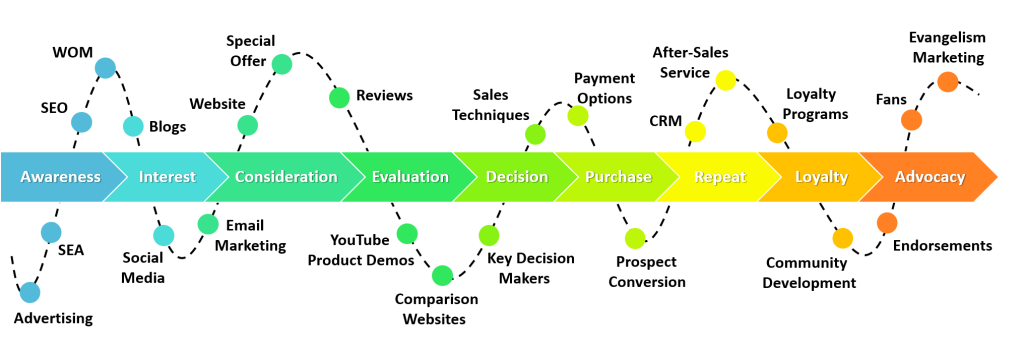According to a Forrester analysis in 2019, a mature program grows twice as quickly as a less mature program and provides a substantial competitive advantage.
Table of contents
Many account managers are now wondering, “What is a mature program?”
A mature program harnesses the entire affiliate economy, from traditional affiliate partnerships to aggregators, content affiliation, influencers, and B2B partnerships.
We’ve witnessed a tremendous surge in interest in brand-to-brand (B2B) partnerships over the last year. From our open B2B affiliate network, where we offer introductions to key points of contact at participating brands, we’ve accumulated a wealth of expertise and insight.
The primary source of interest in B2B partnerships has been two major stakeholders:
- Affiliate Marketing Managers who want to grow their program by leveraging B2B partnerships to drive new customer acquisition or assist existing channels with loyalty and retention.
- Affiliate Managers who want to grow your B2B partnerships and drive new customer acquisition or monetization.
- How to Create a Profitable B2B Partnership in the Performance Channel
Multiple teams are frequently involved in conversations in B2B partnerships. This includes everything from paid social, email, and tech teams to the brand manager and public relations teams.
Align your expectations
To make sure that all stakeholders are on the same page before beginning partnerships, we must first start B2B partnerships:
B2B is a marketing channel in which two or more brands collaborate on campaigns to achieve each of their goals. Typically, these goals are as follows: increased customer acquisition or sales.
Increasing the value of existing audiences by promoting other brands
Or a combination of the two aims listed above.
Determine your primary goals.
Before beginning any B2B affiliate activity, it is critical to determine what you hope to gain from collaborating with another brand. Is your goal to monetize the current audience, attract a new audience to your brand, or a combination of the two? Are you thinking of doing a joint promotion with another like-minded brand? A B2B affiliate partner must be a good fit for all sides in order to be successful. To determine whether a partnership is likely to be a good fit, you must first understand your goals.
Start by looking within – first, ask yourself, “What can we offer prospective partners?” This could simply be a commission for customer referrals, or it could be the option to refer new customers in exchange for a commission. It could be something completely else. Understanding exactly what you have to offer allows you to align your ‘toolkit’ with your goals.
While acquisition and monetization are the most typical goals, it’s important to realize that they don’t have to be mutually exclusive. Because of their greater flexibility, brands that are open to two-way/reciprocal partnership options generally find negotiations with prospective partners more fruitful.
Identify possible partners
When building the groundwork for your B2B partnership, you and your fellow stakeholders are likely to have some suggestions for brands with which you’d like to collaborate on the campaign. Consider brands to whom your brand can add reciprocal value, as well as brands with which your brand already works and with which you have an established relationship.
The partnership’s goal should be to align the two brands, build trust between the two audiences, and provide value to the customer. Brands can develop three sorts of partnerships. We classify them as follows:
Primary partners
Primary partnerships are critical opportunities in the customer journey once they have purchased from a certain brand. If a travel company sells a flight, the customer must get to the airport. Transport choices are a key partner in this circumstance.
Secondary partners
These are ‘nice to have’ promotions with extra value. The user is in the market to purchase, but the opportunity is not critical. A customer on holiday may want to learn more about local cuisine or purchase tickets to an event; for example – the user is in the target market of the partner brand.
Partners in common
Affinity partners are partnerships in which the two brands do not have a direct link. These are possibilities to bring together two brands with similar audiences. For example, if a customer is going on holiday, they may wish to purchase a piece of new luggage, sunglasses, or swimwear.
We can see where each sort of partnership fits into the customer journey below:

The goal is to develop various levels of brand partnerships. For example, a company may concentrate on primary partnerships, and the affiliate or partnerships manager can expand on this with secondary or affinity relationships.
Looking for B2B opportunities?
At this point, make use of the marketing resources at your disposal. Brands frequently have an active social audience. We employ technology at Silverbean to determine brand fit based on audience data.
For example, we looked for prospective partnerships for Barbour using our affinity tool. We discovered that 18% of Barbour’s Instagram audience followed GoPro.
- Chanel was followed by 16.7 percent of the population.
- Starbucks was followed by 14.5 percent.
- Mercedes Benz and BMW were followed by 12.7 percent.
As a result, all of these brands are potential secondary or affinity partners.
They may manage relationships and move each potential B2B partnership into the appropriate tier by using this data to find shared audiences and brands. It also assists brands in developing internal business justifications for campaign marketing exposure or spending.
Building brand-to-brand partnership campaigns
It is important to demonstrate the commercial value of a partnership early in order to enable larger team buy-in as the possibility grows.
The process outlined below examines how you can create a partnership opportunity.
Utilize existing resources.
Consider leveraging your affiliates to drive a campaign if you want to test and learn through a campaign with another brand. You’ll be able to preview the commercial benefits of the collaboration this way.
Increase your digital activity.
Consider gathering other channel managers from PPC, paid social, and email to seek their feedback on an affiliate deep link campaign. Paid social media and email campaigns in order to promote one or both brands are excellent ways to turn a campaign around quickly.
Conclusion
The preceding stage will have supplied quantifiable evidence of the relationship’s worth. If everything is going well, further collaboration should be the logical next step. This may entail resourcing full integrations into your brand’s core website to promote the service, integration within the booking funnel, or additional marketing activity such as sponsorship, offline promotions, or in-store activations.
Last Updated on October 19, 2020





